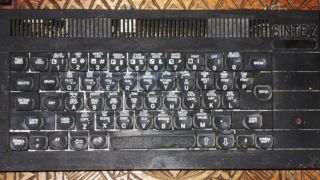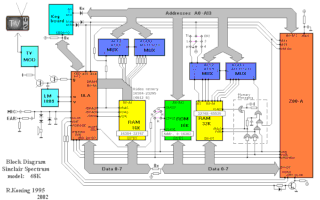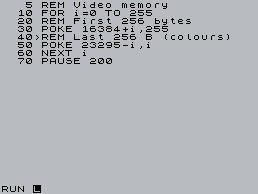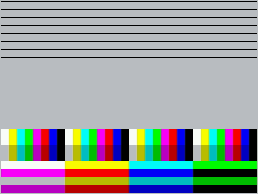best viewed with NetSurf

ZX Spectrum emulators Online emulator
Below is a free emulator written in JavaScript, named JSSpeccy v1. More advanced versions exist, i.e. v2 and JSSpeccy 3, but I included this one because it's the only version that I could run offline and it works in Firefox 10 from 2012. You can download it and put it on your site. It doesn't have sound. The original ROM file that came with the emulator is replaced with OopenSE BASIC
OpenSE BASIC is an open source replacement firmware for the ZX Spectrum and clones that includes many improvements over the original, while retaining a high level of compatibility.
Press Power On, then Start, then Open and select a file. The first 3 files are games and the last 2 are programs written in BASIC. The games are:- Chequered flag, 1983, driving simulation; keys: 9 - acceleration; i - brake; a - left; f - right; m, n - change gear
- Chess - The Turk, 1983, turn-based strategy game
- XOR, 1987, puzzle; keys: z - left; x - right; p - up; l - down; Enter - change player character
JSSpeccy
a ZX Spectrum emulator in Javascript
JSSpeccy homepage (including downloads and source code)
Based on Fuse by Philip Kendall et al. Icons from Nuvola by David Vignoni.
CloseThis program is free software: you can redistribute it and/or modify it under the terms of the GNU General Public License as published by the Free Software Foundation, either version 3 of the License, or (at your option) any later version.
This program is distributed in the hope that it will be useful, but WITHOUT ANY WARRANTY; without even the implied warranty of MERCHANTABILITY or FITNESS FOR A PARTICULAR PURPOSE. See the GNU General Public License for more details.
You should have received a copy of the GNU General Public License along with this program. If not, see <http://www.gnu.org/licenses/>.
The ZX Spectrum
The ZX Spectrum is a home computer released in 1982 and based on the Z80 CPU, which is superior to the 6502 CPU
Although only an 8-bit CPU, the Z80 can run a preemptive multitasking operating
system. Features such as memory protection, which the Z80 lacks, are not essential in such an OS.
[...]
While the MOS Technology 6502 cannot move the stack pointer, the Z80 can freely relocate it to any position
in memory, which makes it easier to implement preemptive multitasking. The existence of an alternative
register set accelerates context switching between tasks dramatically.
 Keyboard of ZX Spectrum Sintez 2, made in Republic of Moldova, 1993
Keyboard of ZX Spectrum Sintez 2, made in Republic of Moldova, 1993
|
 Diagram of ZX Spectrum 48K
Diagram of ZX Spectrum 48K
|
In the ZX Spectrum's memory, each address stores 8 bits (1 byte) and the Z80 CPU can handle an address size of 16 bits, so 216 = 65536 B = 64 KiB of memory can be accessed directly by the CPU. The model with 48 KiB of RAM has 64 KiB of memory in total, of which the first 16 KiB (addresses 0—16383) are read-only memory (ROM), storing a BASIC
Sinclair BASIC was originally developed in 1979 for the ZX80 by Nine Tiles. The programmers
were John Grant, the owner of Nine Tiles, and Steve Vickers.
[...]
In 48K models and older, the keywords are entered via Sinclair's unique keyword entry system, as [can be deduced
from the image above]. The most common commands need one keystroke only; for example, pressing
only P at the start of a line on a Spectrum produces the full command PRINT. Less frequent commands
require more complex key sequences: BEEP (for example) is keyed by pressing CAPS SHIFT plus
SYMBOL SHIFT to access extended mode (later models include an EXTENDED MODE key), keeping
SYMBOL SHIFT held down and pressing Z.
POKE addr,i
This writes i, which can be between 0 and 255 = 28 - 1, at physical address addr. If addr is in the framebuffer (addresses 16384—23295), the result is immediately visible on the screen.
 BASIC program with POKE
BASIC program with POKE
|
 Screen output (resolution is 256x192)
Screen output (resolution is 256x192)
|
Download links
Emulators
Games
Free Unix Spectrum Emulator
OpenSE BASIC
Bars3d - program written in BASIC included with the emulator above, which is also provided
More emulators